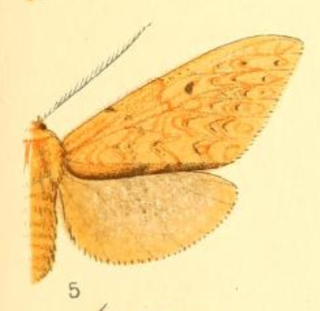Cibyra ferruginosa is a species of moth of the family Hepialidae. It was described by Francis Walker in 1856 and is known to live in the northeastern region of Brazil.
Druceiella basirubra is a species of moth of the family Hepialidae. It was described by William Schaus in 1901 and is known from Bolivia and Peru.
Repnoa is a genus of moths in the family Megalopygidae. It contains only one species, Repnoa imparilis, which is found in French Guiana.
Episcepsis capysca is a moth of the family Erebidae. It was described by William Schaus in 1910. It is found in Costa Rica.

Episcepsis sixola is a moth of the family Erebidae. It was described by William Schaus in 1910. It is found in Costa Rica.

Lophocampa margona is a moth of the family Erebidae. It was described by William Schaus in 1896. It is found in Mexico.
Thelosia truvena is a moth in the family Apatelodidae. It was described by William Schaus in 1896. It is found in Brazil.
Langsdorfia coresa is a moth in the family Cossidae. It was described by William Schaus in 1901 and is found in Colombia.
Givira durangona is a moth in the family Cossidae described by William Schaus in 1901. It is found in Mexico (Durango) and the United States, where it has been recorded from Colorado.
Givira watsoni is a moth in the family Cossidae. It was described by William Schaus in 1901 and is found in Brazil.
Hypopta pallidicosta is a moth in the family Cossidae. It was described by William Schaus in 1901 and it is found in Paraná, Brazil.
Givira carisca is a moth in the family Cossidae. It is found in Mexico.
Givira pardana is a moth in the family Cossidae. It is found in São Paulo, Brazil.
Givira sabulosa is a moth in the family Cossidae. It was described by William Schaus in 1901 and is found in São Paulo, Brazil.
Preptos is a monotypic moth genus in the family Eupterotidae. Its single species, Preptos oropus, is found in Mexico and Guatemala. Both the genus and species were first described by William Schaus in 1892.
Megalopyge braulio is a moth of the family Megalopygidae. It was described by William Schaus in 1924. It is found in Paraguay.
Megalopyge obscura is a moth of the Megalopygidae family. It was described by Schaus in 1905. It is found in French Guiana.
Megalopyge ovata is a moth of the Megalopygidae family. It was described by Schaus in 1896. It is found in Brazil.
Mesoscia pascora is a moth of the family Megalopygidae. It was described by William Schaus in 1900. It is found in Brazil.
Podalia albescens is a moth of the family Megalopygidae. It was described by William Schaus in 1900. It is found in Brazil.

